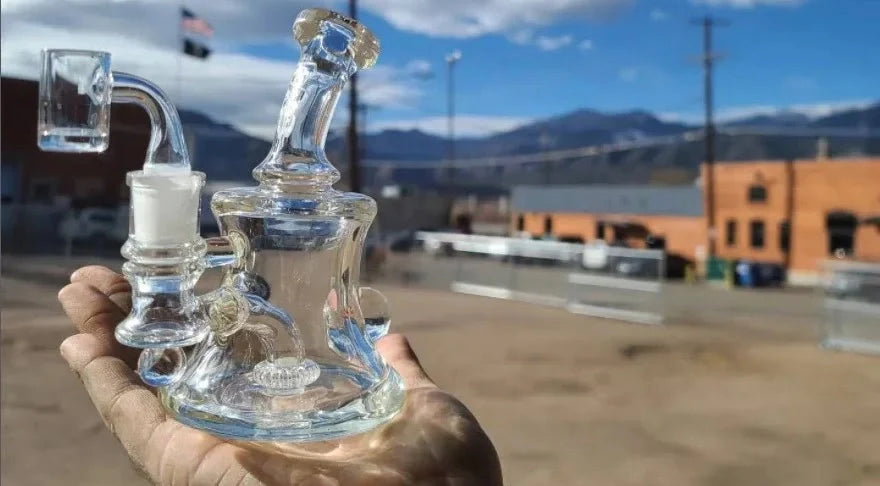How Are Bongs Made? Exploring Different Manufacturing Styles
An overview of bong-making techniques, exploring artisanal methods, mass production, and high-end engineering.
Let’s be honest, most of us never think twice about what goes into a bong beyond the hit.
But behind every smooth pull and perfect stack of bubbles is a story of fire, form, and function.
Bongs aren’t just tubes with water. They’re precision instruments shaped by heat, physics, and more engineering than expected.
Whether you’re toking from a straight shooter, a beaker base, or a labyrinthine recycler, every part of that piece was designed with intention… or at least, it should’ve been.
From the early heat of the furnace to the last flame-polished edge, this is a process rooted in craft—and occasionally compromised by mass production shortcuts.
This article explores how bongs should be made: thick, consistent, and engineered for performance.
What Is a Bong Made Of?
The material impacts everything: heat resistance, airflow, flavor purity, even how easily it survives a clumsy elbow.
While glass dominates the conversation (and for good reason), there’s a surprising variety in what manufacturers use, and not all of it lives up to the ritual it’s meant to serve.
Borosilicate Glass vs. Other Materials
Borosilicate is the backbone of serious smoking gear. We’re a little biased, but let me tell you why.
Resistant to thermal shock, it can handle rapid temperature swings without cracking. That’s crucial when you’re going from ice cubes to a roaring torch. It’s also chemically inert, which means no weird aftertastes or leaching.
That said, not every “borosilicate” bong is the real deal.
Some low-end brands use soda-lime glass and slap on the label anyway, banking on buyers who won’t know the difference until it breaks—or worse, pops in a hot rinse.
Thickness matters too, but only to a point.
What About Silicone, Acrylic, and Ceramic Bongs?
Silicone and acrylic bongs win points for portability and price, but they can mute flavor and warp with use.
Ceramic bongs can be artful, sure, but they’re fragile, heavy, and often lack airflow refinement.
If you're chasing clean hits, consistent function, and a lifetime piece? Glass still reigns.
The Glassblower’s Process: How Artisan Bongs Are Made
When it comes to high-end bongs, the process is about balancing art, science, and strict technical control.
Each curve, weld, and chamber must serve both form and function. Artisan glassblowing isn’t fast, and it’s certainly not easy, but it’s the only way to achieve that unmistakable “pull” serious smokers swear by.
Let’s walk through what separates handcrafted excellence from factory churn.
Step-by-Step: Traditional Glassblowing
It all starts with borosilicate rods or tubes, heated in a furnace to roughly 1,600°C, where they glow soft and syrupy.
This molten stage is critical—too cool, and the glass won’t form right; too hot, and it slumps uncontrollably.
From there, the piece is mounted on a lathe, which slowly spins the glass while it’s worked with paddles, marvers, and blowpipes. This rotational symmetry is what keeps a bong stable when it sits on a table—and makes it comfortable to hold.
The base or water chamber is shaped first.
It’s inflated like a balloon, controlled entirely by the blower’s breath and hand tools. Next comes the neck, which is reheated and elongated into a smooth cylinder, typically with a taper for better draw control.
The mouthpiece is formed last, flared for comfort and safety. For more advanced builds, the artist will add percolators—tiny, functional glass sculptures—and ice pinches, indentations inside the neck designed to catch cubes without impeding airflow.
Cold Working & Decorative Touches
Once cooled to a manageable state, the glass enters its cold-working phase.
This is where logos are sandblasted, edges are flame polished to a glossy finish, and sometimes intricate engravings or millie chips are embedded.
High-end makers also add signatures, serial numbers, or even QR codes etched into the base—not just for style, but for authentication and warranty tracking.
The Annealing Phase: Why It Matters
Before a bong is done, it has to be annealed—a slow, controlled cooling process inside a kiln at about 700°C. This step relieves internal stress that can cause cracking days or weeks later. Skip this, and your bong may look perfect… until you rinse it in warm water.
Wondering how to tell if a joint weld is weak?
Check for uneven coloration or faint bubbles where the pieces fuse. Hot welds (done during the blowing process) create seamless joints. Cold welds (done after cooling) tend to be more brittle and visibly imperfect.
In well-made bongs, you’ll rarely notice the welds at all. And that’s the point.
Precision in Modern Bong Manufacturing
For years, bong design was driven more by art than accuracy.
Beautiful? Sure. Functional? Sometimes.
But modern manufacturing has shifted the conversation. No longer is it just about how a piece looks on the shelf—it’s about how it performs, hit after hit. And when done right, the difference is instant.
Clean airflow. Effortless pull. Zero drag. That’s not a happy accident. It’s engineering.
CAD-Designed Bongs: Function Over Flash
Enter CAD modeling—the unsung hero behind the most consistent, well-balanced bongs on the market.
With programs like SolidWorks, brands like Thick Ass Glass (TAG) build each design in 3D before a single flame is lit. Every curve, angle, and weld is planned digitally, eliminating guesswork and ensuring precision across batches.
CAD gives us control over the pre-production process. When airflow is mapped in advance, drag is reduced, turbulence is minimized, and the smoker feels the difference.
You’re not fighting the piece to get a pull, you’re flowing with it. It’s the kind of upgrade you don’t know you need until you try it.
And let’s ditch the myth that “glass is glass.” It’s not.
A poorly designed bong might have thick walls and flashy percs, but if the internals restrict flow, the result is a choked, muted hit. Function-first design flips that.
Modular Production: Assembly with Purpose
Modern bong production blends hand-blown craft with machine precision.
Instead of blowing every piece in one go, components like necks, chambers, and percolators are made separately, then fused with controlled heat. This modular approach allows tighter tolerances and stronger bonds—when done correctly.
The problem? Mass producers often cut corners. Cheap joints, sloppy welds, and bottom-barrel downstems are bundled into what looks like a premium bong… until you use it.
“Why does my bong hit feel restricted?”
More often than not, it’s the downstem. Poor design or tiny slits act like bottlenecks, trapping smoke and killing airflow. Add in an inefficient perc and you've got drag city.
TAG addresses this head-on, outfitting their pieces with super slit downstems and multi-hole bowls designed to move smoke—not muffle it.
Can You Make a Bong at Home?
It’s a tempting thought: skip the store, grab some tools, and make your own bong.
For the creatively inclined (or just the budget-conscious), DIY seems like a rite of passage. And while there’s nothing wrong with a little experimentation, let’s be clear—when it comes to glass, this isn’t your average craft project.
There’s a thin line between resourceful and risky, and crossing it can lead to more than just a bad hit.
Safety First: Why DIY Glassblowing Is Risky
Working with molten glass is extremely hazardous without professional tools and experience.
Inhaling toxic fumes, suffering burns, or creating structurally unsound pieces are real risks. Glassblowing requires controlled temperatures, ventilation, and precise equipment—none of which should be improvised.
Still determined to go DIY? Consider safer alternatives: bamboo tubes, plastic bottles (short-term use only), or rigs with 3D-printed downstems.
They won’t deliver the smoothness of borosilicate, but they won’t shatter in your face either.
When Homemade Works—and When It Doesn’t
Some homemade pieces function decently, especially with simple, gravity-based designs.
But even the best DIY builds often suffer from poor airflow, leakage, and inconsistent pulls. Most don’t account for airflow angles, percolation efficiency, or heat dissipation.
In short: DIY is a fun exercise. But for daily use? Trust the pros.
Quality Control & Manufacturing Red Flags
There’s a lot of glass out there that looks solid—until you actually use it.
The truth is, many brands rely on appearance to do the heavy lifting, banking on the fact that most buyers won’t notice weak welds, crooked joints, or airflow issues until it’s too late. That’s where quality control makes all the difference.
Second Quality vs. First Quality
At Thick Ass Glass, we introduced the Second Quality grading system to bring transparency where the industry had none. Not all flaws affect function—but customers deserve to know the difference.
First Quality means the piece meets all specs for performance, durability, and build integrity. Second Quality might show slight visual defects—tiny bubbles, minor lean, subtle warps—but still functions well. More serious defects, like porous welds or loose joints, don’t make it past inspection.
Knowing what to look for helps: uneven percs, off-center welds, or joints that wobble under light pressure. If a piece feels “off,” it probably is.
Lifetime Warranties & Industry Gimmicks
Plenty of brands throw around terms like “lifetime warranty,” but read the fine print—it usually means you’ll pay 50% or more to replace a broken piece. That’s not a warranty; that’s a discount.
TAG’s 2-year, no-questions-asked replacement policy for First Quality pieces raises the bar.
If your piece breaks—for any reason—we’ll replace it for the cost of shipping. No games, no hidden fees. That’s how real confidence in craftsmanship looks.
Glossary of Bong-Making Terms
Even seasoned smokers run into technical terms that sound more like engineering jargon than smoking gear. Here’s a quick-reference glossary to help decode the science behind your favorite glass.
-
Annealing – A controlled cooling process used to relieve internal stress in glass after it's been shaped. Prevents cracking from temperature changes or minor impacts.
-
Percolator (Perc) – A built-in filtration feature that diffuses smoke through water. Common types include tree, honeycomb, matrix, and showerhead.
-
Downstem – The tube that connects the bowl to the water chamber. Quality versions include diffusion slits or holes to improve airflow.
-
Cold Work – Post-blow techniques like sandblasting, engraving, and polishing. Adds logos, finishes, and design details after the glass has cooled.
-
CAD (Computer-Aided Design) – Software used to digitally model bong designs before physical production. Ensures consistency, precision, and optimized airflow.
-
Thermal Shock – Rapid changes in temperature that cause glass to expand or contract too quickly. Borosilicate glass resists this, preventing breakage.
-
Weld (Hot vs. Cold) – The joint where two pieces of glass are fused. Hot welds are seamless and strong; cold welds are weaker and may appear cloudy or bubbled.
-
Ice Pinch – Indentations inside the neck of a bong that hold ice cubes. Cools smoke without affecting airflow.
-
Joint – The part where the downstem or bowl inserts into the bong. Can vary in size (e.g., 14mm, 18mm) and angle.
-
Recycler – A style of bong or rig that continuously cycles water for extra filtration. Prevents splashback while enhancing smoothness.
Always Seek Quality in Your Bong
A great bong is thick and thorough.
Every weld, curve, and perc should serve a purpose beyond aesthetics. Whether you prefer the fast clear of a straight tube, the stability of a beaker, or the refined draw of a recycler, your piece should match how you smoke—not just how it looks on a shelf.
Prioritize real borosilicate, smooth hot welds, and glass that’s engineered, not just assembled. Avoid the gimmicks, the unnecessary flair, and the cheap bundles that underperform.
If you’ve ever wondered what a perfectly tuned bong should feel like, try one from our collection that is designed with real airflow engineering in mind.


